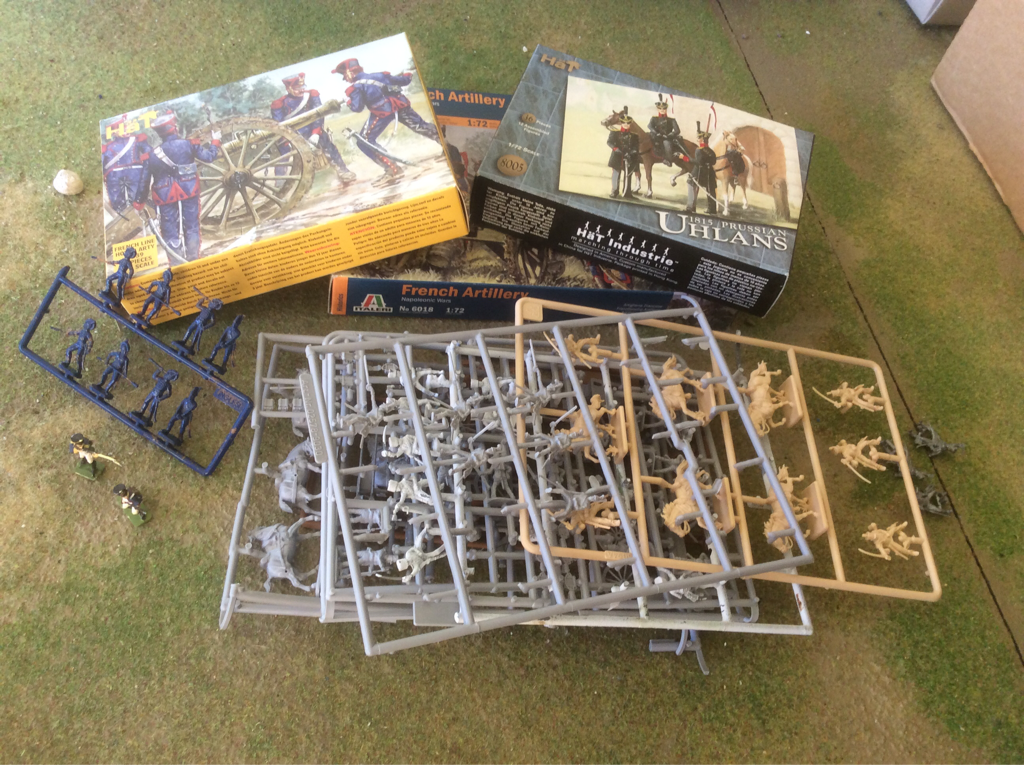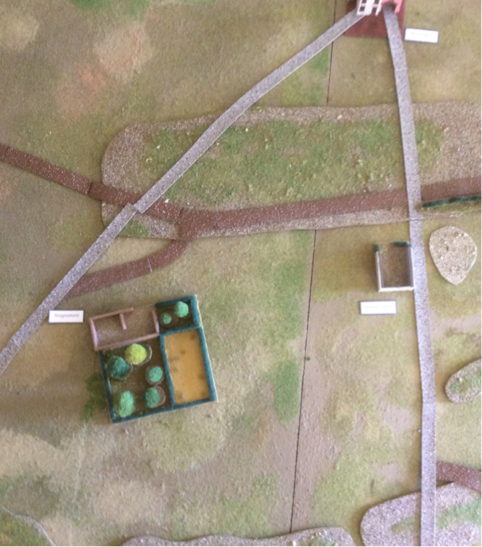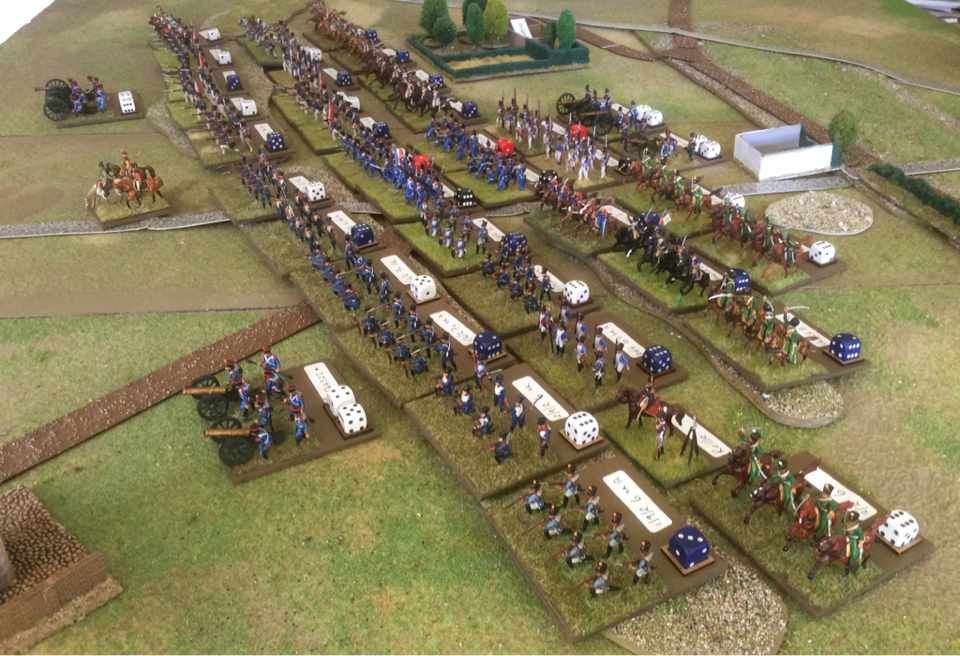|
This and the next blog post contain the first battle report I wrote when I created this web page. New to the whole blogging business, I put it on a standard web page where it didn't really belong. I am now tidying up the site but didn't want to lose the report so here it is again. The 20 year Waterloo projectIn 2015 we played a refight of the Battle of Waterloo, using Honour Games’ Blücher and a figure collection that started in 1995. Back in 1995, I had just picked up Frank Chadwick's Napoleon Returns, his 100 Days Campaign book for Volley & Bayonet. At the time all our Napoleonic armies were in 15mm and I didn't have any Anglo-Allied figures at all. I thought it would be quicker and cheaper to create the Order of Battle for 1815 using plastic 20mm figures. My older son was showing interest in toy soldiers and the slightly larger figures appealed to him more than the 15s. To spread the budget, I based only 8 foot or 4 horse on each 3" square base, with a bare strip at the back for an information sticker. I set out to paint in a toy soldier style and was helped in the early stages by my sons. The project got off to a good start but was mothballed as my sons and I fell heavily for Warhammer and WH40K. We spent many happy years building and fighting with Games Workshop armies while the 20mm project gathered dust in the attic. Then in 2009 I chanced upon Sam Mustafa's Fast Play Grande Armee and dug the plastics out of the roof space. There were now many more plastic figures on the market than in the mid 90s and some were very fine sculpts. By summer 2010 I had painted the Order of Battle for Quatre Bras, which my friend Mark and I played to test the rules. A few months later four of us played a refight of D'Erlon's attack at Waterloo. There followed breaks for the 17th Century, then the War of Spanish Succession, tactical Napoleonics and the ACW, but in between other periods, I kept adding to the Napoleonic collection. With the bicentennial looming I decided it was time I finally put all the figures on the table and so I invited my regular opponents to a Waterloo multiplayer refight on 12 July 2015. Which rules?The first options for a whole battle refight were Napoleon's Battles, Volley & Bayonet and Grande Armee. We still play Napoleon's Battles occasionally but they don't please everyone and can play a bit slowly unless the players know the rules really well. Both Volley& Bayonet and Grande Armee give a faster game. But a new rules book had just been published that settled the decision for me. In early 2015 I acquired Sam Mustafa's new Big Battle rules set, Blücher. We have already played a lot of Sam's rules, especially Longstreet and Lasalle as well of course as Grande Armée. Blücher has not disappointed. For our first game We played a Franco-Austrian 1809 fight for a group of friends who game regularly but didn't know historical Wargames. It worked a treat: four complete beginners fought a large battle very happily inside one day. Keith (my longest-serving opponent) and I then played Plancenoit twice, using Sam Mustafa's 100 Days unit cards. Both games were tense and rewarding. So Blücher it was. A unit in Blucher mostly represents a brigade although some French Cavalry units represented whole understrength divisions. Each unit starts with a number of élan points (typically 6) that reflect its fighting quality. These determine how many dice to roll in fire and hand to hand combat. The dice can also be affected by attributes such as a good skirmish ability; attached artillery; shock power in the attack and so on. Élan is lost through combat and when reduced to 1 élan point, a unit dissolves. Blucher rewards the side that keeps fresh troops to throw in when the enemy is wearing down. The mechanics of the whole game are simple but subtle. Blücher is relaxed about figure and ground scales, encouraging players to adapt to the battle in question and the size of their collection and games table. In this case, I went for one inch to represent 100 yards and one unit to be a brigade. This scale, is already used in Napoleons Battles, Volley & Bayonet and Grande Armee. Fortunately, the 3" square units I have been collecting over two decades fit well with Blucher's scale so I didn't face a rebasing challenge. The Frank Chadwick Order of Battle for 1815 also reads across well, although his rules required many more commander figures and skirmisher bases. I'll have to find a use for all my surplus generals! The main task was to repaint the rear strip of the unit bases from green to earth brown. This was the third colour change since the project began but Earth brown bases seem to be the least intrusive so far. I also bought a lot of mdf dice cells from Warbases and glued one to the back left corner of every unit. The dice would show the number of elan points remaining, while their colour would show what special attributes each unit had. For example, white would be skirmish only; black skirmish and attached artillery; green for conscripts etc. I also wrote these attributes on the unit labels. Preparing the tableMy usual gaming table is 8' by 4'. For this game I added an extension, which took the table breadth to 10'. I thought the map would be easy to translate to the table, but was surprised to find several variations between the maps I looked at. You might expect this battlefield to be so well known that all maps would be identical. I went with the maps in Mark Adkin's Waterloo Companion where there was confusion. With such a large ground scale and 20mm figures, it is a challenge to represent villages. I made a lot of square bases of cobbles, cut from moulded plastic card for model railways. I stuck some low walls around the edges of each base and placed buildings from my 15mm collection on them. Not that impressive to look at but at least the troops are now defending something. I also considered making La Haie Sainte and Hougoumont bigger to accomodate larger bases but decided the space in the Centre of the battlefield was cramped enough as it was, so the chateau and farm's footprints are to scale. This made it impossible to garrison either the farm or chateau with a standard Blucher unit. I created a scenario-specific house rule to handle this, discussed below. As for contours, I wanted to create reverse slopes but not overdo the sharpness of the crest line. I used flat contour shapes, mostly cut from plywood and MDF, to make sure the battlefield has the right rolling feel. My polystyrene hill models are too steep and high for the job. The only penalty the contours conferred would be on line of sight and incoming artillery fire. I wanted to create space to East and West of the field, to allow for possible developments on either flank. For the sunken road, I relied on the distances provided by Adkin. To represent it, I lined the road with a hedge made of cut up pan scourers. This is confined to a few inches eastward from the Mont St Jean crossroads. I kept the oval sandpit from a refight of I Corps' attack a couple of years ago. The ScenarioThe day was set to run from turn 9 to 36, using the high summer game length in the advanced rules. The French were first side and each side had 3 Momentum (MO) dice per turn. I decided to use the multiplayer rules from the book, where every player on a side keeps a tally of MO use and the turn ends when the first player reaches the MO limit. I decided that the Anglo Allies would mobilise by division and not by Corps. The Corps in Wellington's army of 1815 was more an administrative designation than operational, and it felt wrong to treat it in a way comparable to a French Corps. However, I did allow the Allies to pay only 1MO per unit in an activated division. (If you don't know the rules I've probably lost you. Basically, this meant that an Allied player could not activate more than one division in a round, so mostly in smaller packets than the French). Morale levels were set at one third of army totals, so 17 for the French and 11 for the Allies. Reinforcements to either side would increase this limit, which meant the Prussians would not have their own morale level. I did not give the French a higher level for The Napoleon effect: while hard-hitting, the French army of 1815 was brittle. The Orders of battle we used are on the Napoleonic scenarios page here. For the order of battle, I decided not to tamper with the troops on table on the morning of the 18th. After all, this wouldn't be a Waterloo refight without D'Erlon, Reille and the rest. I did however leave the players to choose their deployment. Also, I wanted to create some uncertainty for both sides over who might appear in the distance and when. I wrote a decision tree which required a dice roll every few turns. The decisions were, broadly in sequence: Will Blucher commit to reinforce Wellington? Will Grouchy begin to move earlier in the day than he did historically? Will Grouchy try to drive through Wavre; seek to reinforce Napoleon directly via a side route or a mix of both? If Grouchy assaults Wavre will his pressure on Thielmann be heavy and if so, will this affect the pace or quantity of Prussian reinforcements arriving at Waterloo? How fast will reinforcements (of either nationality) march towards the sound of the guns? I won't go further into the mechanics but the probabilities varied according to my preconceptions. For example, I wanted there to be a possibility that Blucher would not commit to move to Waterloo, but the chances of rolling this result were very small. The outcomes therefore ranged from the Prussians arriving pretty much as they did, all the way to no Prussians arriving or even a small French reinforcement. But to be frank, the chances were stacked in favour of history repeating itself. The player briefings and battle report are in the next post.
0 Comments
Leave a Reply. |
Archives
November 2023
Categories
All
|




 RSS Feed
RSS Feed